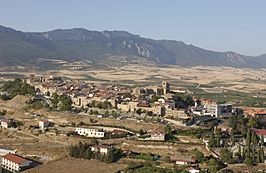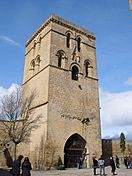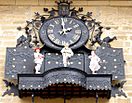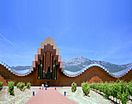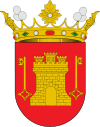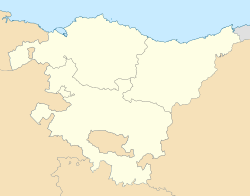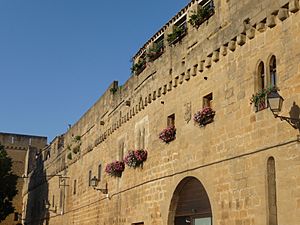Laguardia, Álava facts for kids
Quick facts for kids
Laguardia
|
||
|---|---|---|
|
||
| Country | ||
| Autonomous community | ||
| Province | ||
| Eskualdea / Comarca | Rioja Alavesa | |
| Founded | 1164 | |
| Area | ||
| • Total | 81,08 km2 (3,131 sq mi) | |
| Elevation | 630 m (2,070 ft) | |
| Population
(2018)
|
||
| • Total | 1,505 | |
| • Density | 0.18562/km2 (0.48075/sq mi) | |
| Time zone | UTC+1 (CET) | |
| • Summer (DST) | UTC+2 (CEST) | |
| Postal code |
01300 / 01308 / 01309 / 01321
|
|
Laguardia (also called Basque: Guardia) is a small town in northern Spain. It's located in the southern part of the Álava province, within the Basque Autonomous Community. It's part of the Rioja Alavesa region. About 1,500 people live there today, but in the past, it had more residents, around 2,500.
The town sits on top of a hill and is surrounded by a strong wall. King Sancho the Strong ordered this wall to be built a long time ago. You can still see five different entrances to the town through this wall. Their names are Mercadal, Carnicerías (Butchers), Páganos, San Juan, and Santa Engracia. The streets and areas around Laguardia still feel like they are from the Middle Ages, giving the town a very old and special charm.
The main way people in Laguardia make a living is through the wine industry. Many wineries in the area make and process wine.
Contents
Town's Name: What's in a Name?
During the Middle Ages, Laguardia was known by several names. Some of these included Leguarda, Giardia, Guard, Guoardia, Lagarde, and Laguoardia. Eventually, the name we use today stuck. The full name for the town is actually La Guardia de Navarra Sonsierra.
For a while, there was a discussion about the Basque name for the town. Many people thought that before Laguardia became an official town in 1164, it was called Biasteri. They believed Biasteri was a Basque name. Some even thought it meant "two rock towns." Because of this, Biasteri was used as the Basque name for Laguardia until recently.
However, in the late 1900s, experts like philologists (who study languages) and historians did more research. They found out that Biasteri was actually the old name for a nearby town called Viñaspre, not Laguardia. So, the connection made before was wrong. The Basque Language Academy, Euskaltzaindia, decided that the correct Basque name for the town is Guardia.
Neighborhoods of Laguardia
Laguardia has three smaller areas, or neighborhoods, that are separate from the main town:
- The Campillar: This area is about 7.5 kilometers (4.7 miles) from the town center. It's close to the Ebro River and has about 28 residents.
- Laserna: This neighborhood is about 11 kilometers (6.8 miles) from the town center. A bend in the Ebro River separates it from the rest of the municipality. About 43 people live here.
- Páganos: This area is 3.5 kilometers (2.2 miles) away and has about 87 residents.
Laguardia's History
Laguardia has a very interesting past. In a place called La Hoya, there's an important archaeological site. This was once a settlement of the Celtiberian people, called Berona, even before the Romans arrived. People lived here for over a thousand years, from the 12th century BC to the 2nd century BC.
In 1164, King Sancho VI "El Sabio" of Navarre gave Laguardia special rights. This marked the beginning of the "Villa y Tierra" community, which included Laguardia and its surrounding lands. Over time, new towns were created nearby, changing the focus to other areas like San Vicente and Viana. Still, Laguardia was the most important town in the Sonsierra of Navarra region for much of the medieval period.
Economy: The World of Wine
As mentioned, the main part of Laguardia's economy is all about wine. This includes growing grapes, making wine, and the entire wine industry. Laguardia is the capital of one of Spain's most famous wine regions, Rioja Alavesa. In Laguardia and the areas around it, a special wine called Denominación de Origen Calificada Rioja is produced. This name helps people know that the wine comes from specific regions and meets certain quality standards.
Places to Visit in Laguardia
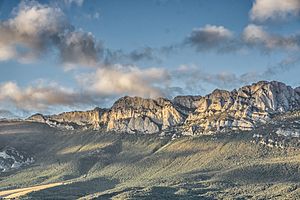
- The Wall: The tall, thick stone walls surrounding the town are about two meters deep. There are five gates that lead into the town.
- The Church of Santa Maria de los Reyes: This church might have been a Templar monastery in the past. Next to it is a tower called the Tower of Santa Maria, or Abbey Tower. It's thought that the abbot (a leader of a monastery) lived there. The tower has a beautiful Gothic facade with a portico (a covered entrance) that is almost perfectly preserved. The carvings were finished in the 14th century and painted in the 17th century. It's one of the few painted church entrances left in Spain. The carvings show the Apostles, and the porch tells stories about the Holy Virgin.
- The Church of San Juan: This church started as a Romanesque building and was finished in the Gothic style. It has a chapel from the 18th century dedicated to the Virgin of Pilar. Its bell tower used to be part of a castle.
- The Hermitage of Santa María de Berberana: This is a Romanesque church and the only one in the entire Rioja Alavesa region that has a square apse (the rounded or polygonal end of a church).
- Plaza Mayor: This is the main square in the center of town. Here, you can find both the new and old town halls. The old town hall has the town's shield on its front. It also has a special clock with moving figures (automata) that dance at 12 PM, 2 PM, 5 PM, and 8 PM to the music of a traditional town parade.
- Renaissance Old Town Hall: This building features an imperial shield of Charles V, a famous emperor.
- The Capuchin convent: A historic religious building.
- Prehistoric remains: You can find ancient stone structures called dolmens and the remains of a Celtic village at La Hoya. There's also a Celtic pond nearby.
- The Birthplace of Félix María de Samaniego: This 17th-century palace was where the famous fable writer Félix María de Samaniego was born. Today, it houses the tourist office.
- Eguren Ugarte: A vineyard with wine caves, a hotel, and tours where you can taste wine.
- Bodega El Fabulista: Another place with wine caves, a hotel, and wine tasting tours.
Famous People from Laguardia
- Blanche of Navarre (1133–1156): She became the Queen of Castile.
- Felix Maria Samaniego (1745–1801): A famous writer known for his fables (short stories with a moral). His birthplace, a 17th-century house, is still preserved and now serves as a wine museum.
- Óscar de Marcos (born 1989): A professional football player for Athletic Bilbao.
Music in Laguardia
Laguardia has a long history of talented musicians. For many generations, bagpipers have been important to the town's music. There's even a special "Day of the Piper" festival to honor these musicians. The town also has a municipal band that has been playing for 130 years! Several rock bands, like "Tubo Skape" and "Allá Cuidaos," have also been part of Laguardia's music scene.
Sports in Laguardia
The town has a football (soccer) team that plays in a regional league. In 1967, Laguardia was the starting point for the 16th stage of the Vuelta a España cycling race. This stage was a time trial that finished in Vitoria, and the French cyclist Raymond Poulidor won it.
Images for kids
See also
 In Spanish: Laguardia para niños
In Spanish: Laguardia para niños


